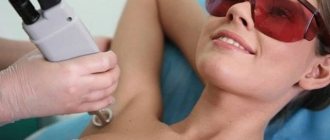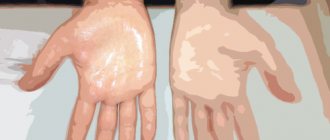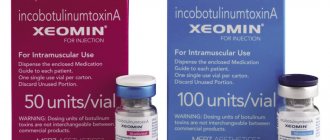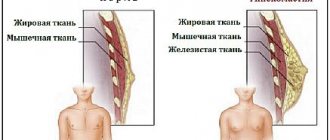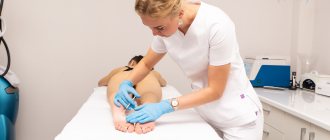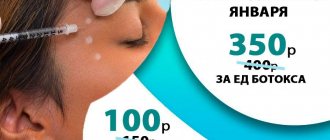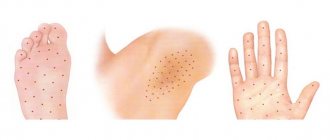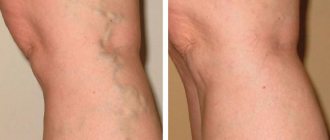Excessive sweating of the feet is a common problem that interferes with a person’s normal lifestyle. Today there are a number of conservative techniques that can partially or completely eliminate this problem. Most often you can get advice on the use of special insoles, antiperspirants, and powders. Often they simply advise you to wash your feet more often or change your socks and stockings. A specialist in the treatment of hyperhidrosis (excessive sweating) will also recommend the use of iontophoresis or botulinum toxin injections (Botox, Dysport).
However, in a number of patients, conservative methods do not help, and the sweating is so strong that they cannot put up with it. We asked a specialist at the center for the treatment of hyperhidrosis, surgeon Vladimir Aleksandrovich Kuzmichev
about what to do for such patients whose feet are constantly wet and sweat literally drips down.
— What should people with severe sweating of their feet do if conservative treatment methods do not help?
Treatment for this type of sweating is quite complicated, but fortunately there are not many such patients. In general, isolated sweating of the feet is an extremely rare condition, and if it first appears in adulthood or old age, it is necessary to look for its cause.
Endoscopic thoracic sympathectomy as a treatment method for palmar hyperhidrosis
Etiology and pathogenesis
The problem of hyperhidrosis is primarily a feature of the sympathetic nervous system, its activity. The number of sweat glands in people suffering from hyperhidrosis is no different from the number of glands in healthy people. The peculiarity of hyperhidrosis is that the predictability of its changes with age is extremely low. It happens that with age, hyperhidrosis may become less pronounced, but these are rare cases. More often, there are situations when, if left untreated, hyperhidrosis that accompanies any disease can become chronic. In general, by eliminating the factors that cause hyperhidrosis, its severity can be reduced, but not completely. Treatment is necessary to completely eliminate hyperhidrosis. In special cases, surgical intervention specifically affects the activity of the sympathetic nervous system.
Indications for sympathectomy
The main indications for sympathectomy are the presence of hyperhidrosis in the palms or soles. This operation is usually recommended by doctors if other non-surgical treatments do not help. In other words, the main indication for the use of sympathectomy is a form of hyperhidrosis that cannot be treated with other methods.
Treatment and diagnostic tactics
Historically, the first type of sympathectomy was open sympathectomy. Its peculiarity was that the operation was performed through a thoracotomy (between the ribs) approach, an incision on the front surface of the neck above the collarbone or behind between the shoulder blades. The first operation of this kind was carried out in 1920. Currently, only endoscopic thoracic or lumbar sympathectomy is an actual operation.
Endoscopic thoracic sympathectomy (ETS) - insertion of a thoracoscope through an incision in the 4th intercostal space, and through the 2nd intercostal space, special instruments are inserted into the chest, with the help of which the operation is performed under the control of an image on a large screen. One of the options for influencing the sympathetic nerve responsible for sweating is clipping. In this case, the integrity of the nerve in the anatomical sense is not violated, but the transmission of nerve impulses that stimulate sweating stops. This is why sympathectomy gives a positive effect in 95-98% of cases. The advantage of this method is that with surgical intervention of this type, trauma is reduced to a minimum. This is because an endoscope is used during the operation, which allows the surgeon to monitor whether the vessels are damaged. The low traumatic nature of such an operation, in turn, has a positive effect on reducing the duration of the rehabilitation period. Endoscopic sympathectomy allows the surgeon to send the patient home within a day.
Endoscopic thoracic sympathectomy (ETS) as a treatment for palmar hyperhidrosis is carried out by blocking the sympathetic nerve trunks that regulate sweating. Currently, the preferred method of blocking is the clipping method, which is a potentially reversible method of influencing the sympathetic trunk. During the operation, special blocking titanium clips are applied to the nerve. The importance of this particular method of influencing the sympathetic nerve is explained by the reversibility of this effect in the event of a side effect in the form of compensatory hyperhidrosis. If the clips are removed, this side effect may disappear completely.
Another advantage of this method is that the entire operation is performed using punctures in the armpit area, which in turn eliminates postoperative scars and, as we have already noted, reduces long-term postoperative rehabilitation. The entire operation lasts 20-30 minutes under general anesthesia.
It should be noted that endoscopic thoracic sympathectomy operations began to be performed more than 50 years ago, and thanks to the development of technology in recent decades, such operations are now performed at a very high level.
Rehabilitation
The hospital stay usually does not exceed one day. The positive effect of the operation becomes visible immediately; in addition, in some cases, foot sweating also decreases. For most patients, the results last forever.
Possible complications. Relapses
Possible side effects include compensatory sweating, which in some cases exceeds the initial level of sweating. Pronounced compensatory hyperhidrosis occurs in 3-4% of operated patients.
There may also be an increase in sweating at certain moments (for example, when eating spicy, spicy foods - 20-30% of patients) - the so-called gustatory hyperhidrosis, it rarely seriously bothers patients. Most people who experience excessive sweating while eating do not experience excessive general sweating, so most of them are satisfied with the consequences of the operation. Complications include Horner's syndrome, ptosis (drooping) of the eyelids (0.5-4.9% of patients). This complication occurs only in inexperienced surgeons. Fortunately, having the operation performed by a surgeon who thoroughly knows the problem eliminates the risk of developing Horner's syndrome. Sometimes a relapse of hyperhidrosis also occurs, which is explained by the regeneration of sympathetic fibers or the switching of the activity of the sympathetic nervous system to other ganglia. Typically, recurrence can be eliminated with repeat surgery.
After sympathectomy, as a rule, dilation of the capillaries of the upper extremities is observed, this manifests itself in the fact that the hands become warm and even hot. It should be noted that this effect of the operation always disappears after 6-8 months.
Contraindications to surgery: secondary hyperhidrosis caused by any other disease, heart failure, mild failure, severe forms of tuberculosis and other diseases.
Compensatory hyperhidrosis after sympathectomy and ways to combat it
Compensatory hyperhidrosis is the most unpleasant reaction of the body to sympathectomy performed for palmar hyperhidrosis and/or Blushing syndrome. In some cases, timely removal of clips (if clipping was performed) helps. Operations to restore the sympathetic trunk have not yet become a routine operation, although our clinic is working in this direction. Meanwhile, many patients abroad have long been using glycopyrrolate to reduce sweating
. This drug is not registered in Russia and cannot be bought at a pharmacy, but motivated patients are persistent and buy it. We are publishing a review from one of our patients about the effectiveness of using glycopyrrolate. IMPORTANT! You should take the drug carefully, be sure to consult your doctor first! Here's an excerpt from a patient's letter:
I was able to order it only with the help of the website https://ustabs.ru. The drug itself costs around $300 (one package of 100 capsules of 2 mg), with all the extra charges it cost me around $800. As a short-term solution to the problem, this drug is certainly very good, but, of course, it depends on the level of hyperhidrosis and the occurrence of side effects. I usually take 1 capsule in the morning on an empty stomach and do not eat for 1.5-2 hours (this is a recommendation for a more effective effect of the drug). In my case, the side effects are as follows: some dry mouth, some dryness in the respiratory tract, some blurred vision. No drowsiness. You can read reviews here: https://www.askapatient.com/viewrating.asp?drug=12827&name=ROBINUL As you can see, some have been taking it for years and are very happy, although there are reviews that the drug did not help someone at all. If the “price is affordable”, then having it on hand at least in case of an important event will definitely not be a waste!
We hope this information will be useful to those suffering from compensatory hyperhidrosis. Once again we warn about the dangers of uncontrolled use of the drug and the need to consult with doctors!
Get rid of sweaty palms and armpits forever
Sympathectomy should be considered as the definitive treatment for sweating of the palms and armpits. After surgery, reversal methods are controversial, just as drug treatment for compensatory sweating is not completely effective. Therefore, the main problem has ceased to be operative aggressiveness and has become the selection of patients who would benefit most from reduction of hyperhidrosis with a lower likelihood of complications.
The diagnosis of hyperhidrosis is made using clinical criteria based on personal history and clinical examination. There is no specific laboratory diagnosis for hyperhidrosis or imaging test (no radiation methods are applicable) to confirm. It should be excluded whether it is secondary to another condition (secondary hyperhidrosis, for example, due to neuropathies or hormonal disorders).
Clinical criteria are the presence of visible patchy sweating for at least 6 months, without any other obvious cause, consistent with at least two of the following criteria:
- bilateral and symmetrical,
- affecting daily activities,
- happening more than once a week,
- starting before age 25,
- family history of hyperhidrosis and absence of night sweats.
- Sweating is clearly influenced by emotional status and stressful situations.
Special instruments exist to measure sweat volume, but they are impractical for clinical use, only as research equipment and can only be used in the laboratory.
Initial treatment of primary hyperhidrosis is conservative. If the patient receives relief from their symptoms without limiting side effects, they will avoid invasive treatment. Local therapy is initially suggested, but may only be effective in milder cases.
Iontophoresis can lead to temporary improvement of palmar and plantar hyperhidrosis, but it has low adherence because it takes time to achieve results and because of its temporary nature.
Botulinum toxin injection also addresses the problem of hyperhidrosis with temporary results. This is an expensive treatment with an average LOS of less than 1 year and may satisfy patients prone to repeated injections.
However, some patients who experience the hyperhidrosis-free period offered by temporary localized treatment will seek something more specific.
Endoscopic lumbar sympathectomy as a treatment method for foot hyperhidrosis
Treatment and diagnostic tactics
This type of surgery helps treat excessive sweating in the feet. Previously, this type of surgery was used, as a rule, to increase blood flow to the lower extremities in case of narrowing of the arteries. However, as a result of this operation, sweating of the feet disappears. Therefore, endoscopic lumbar sympathectomy is also used to treat plantar hyperhidrosis. This type of treatment, despite its effectiveness, is recommended to be used in cases where other methods have already been tried, but did not lead to a positive result.
The operation is performed under general anesthesia and lasts 60-80 minutes. During the operation, the sympathetic nerve trunks located in the lumbar region are excised. Endoscopic lumbar sympathectomy, like endoscopic thoracic sympathectomy, is a minimally invasive and low-traumatic technique, since the operation is performed through small incisions on the lateral surfaces of the abdomen. The peculiarity of this operation is that its consequences are irreparable, since, unlike endoscopic thoracic sympathectomy, the nerve is excised and not blocked with a clip. However, in this case, after surgery, compensatory hyperhidrosis is not expressed.
Rehabilitation
After endoscopic lumbar sympathectomy, the patient spends no more than 2-3 days in the hospital. During the first month, physical activity is prohibited.
Possible complications
A more serious consequence of this type of treatment for the problem of hyperhidrosis is impaired ejaculation in men, although recently the use of limited effects on the sympathetic trunk has led to the elimination of this complication. Rare but possible consequences of lumbar sympathectomy include pain in the legs.
Contraindications to the operation: diseases of the cardiovascular system, pulmonary diseases, infectious diseases of the abdominal wall, previous operations in the abdominal cavity.
Thus, depending on the severity of hyperhidrosis, the area of its manifestation and the general condition of the patient, you can choose the most suitable treatment method, among which surgical methods are in first place in terms of effectiveness.
Main indications
The most important question for people with excessive sweating is in what cases is sympathectomy prescribed. Many people realize that surgery is a risk, and it can provoke various negative consequences. But innovative techniques, modern equipment and the surgeon’s experience can prevent the occurrence of side effects, and the result obtained will justify the risk.
Sympathectomy is effective in solving the following problems:
- vegetative pain syndrome;
- Raynaud's disease;
- erythromelalgia;
- obliterating endarteritis;
- hyperhidrosis;
- Sudeck's syndrome;
- facial redness due to stress (blushing syndrome).
Like any other method of surgical intervention, sympathectomy has contraindications:
- heart, lung or kidney failure;
- severe forms of tuberculosis and other infectious diseases;
- diabetes;
- emphysema;
- pathologies of the endocrine system;
- pleurisy;
- secondary rehidrosis.
How to prepare for surgery
Before sympathectomy, the surgeon prescribes a complete examination of the patient’s body, which includes:
- clinical and biochemical blood test;
- general urine analysis;
- fluorography;
- ECG;
- tests for hepatitis, HIV, syphilis.
As a rule, surgery is preceded by conservative treatment: taking medications, using antiperspirants and pastes. Only if all these non-operative methods have proven ineffective in combating the problem is surgery prescribed.
